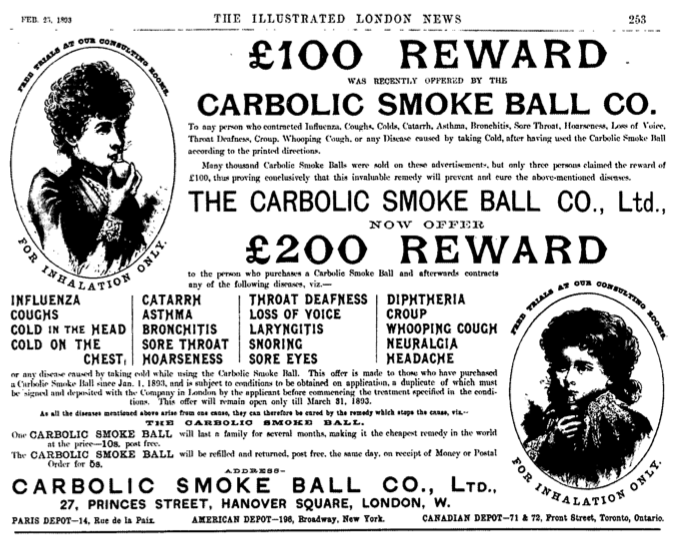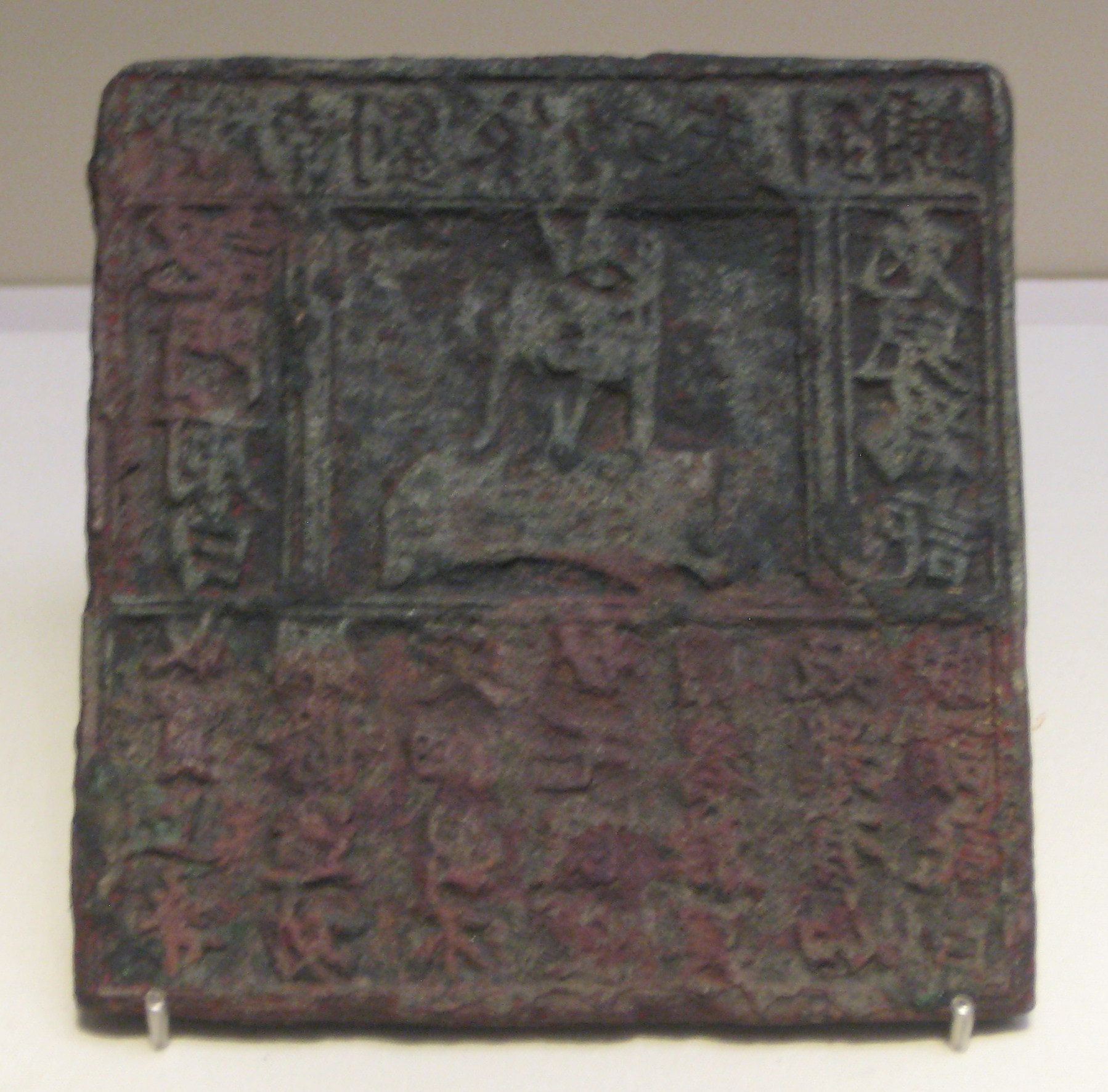|
Puffery
Puffery is undue or exaggerated praise. Puffery serves to "puff up" what is being described. In law, puffery is usually invoked as a defense argument: it identifies general praising speech, typically produced by a seller, which is not expected to be relied upon and does not give rise to legal liability. In a circular manner, legal explanations for this normative position describe the non-enforceable speech as a statement that no "reasonable person" would take seriously. Origin In a legal context, the term originated in the 1892 English Court of Appeal case '' Carlill v Carbolic Smoke Ball Company'', which centred on whether a monetary reimbursement should be paid when an influenza preventive device failed to work. The manufacturers had paid for advertising stating that £100 would be paid in such circumstances then failed to follow this promise. Part of their defence was that such a statement was "mere puff" and not meant to be taken seriously. While the defence ultimately los ... [...More Info...] [...Related Items...] OR: [Wikipedia] [Google] [Baidu] |
Menu
In a restaurant, the menu is a list of food and beverages offered to the customer. A menu may be à la carte – which presents a list of options from which customers choose, often with prices shown – or table d'hôte, in which case a pre-established sequence of courses is offered. Menus may be printed on paper sheets provided to the diners, put on a large poster or display board inside the establishment, displayed outside the restaurant, or put on a digital screen. Since the late 1990s, some restaurants have put their menus online. Menus are also often a feature of very formal meals other than in restaurants, for example at weddings. In the 19th and 20th centuries printed menus were often used for society dinner-parties in homes; indeed this was their original use in Europe. History Menus, as lists of prepared foods, have been discovered dating back to the Song dynasty in China. In the larger cities of the time, merchants found a way to cater to busy customers who had litt ... [...More Info...] [...Related Items...] OR: [Wikipedia] [Google] [Baidu] |
Carlill V Carbolic Smoke Ball Company
''Carlill v Carbolic Smoke Ball Company'is an English contract law decision by the Court of Appeal, which held an advertisement containing certain terms to get a reward constituted a binding unilateral offer that could be accepted by anyone who performed its terms. It is notable for its treatment of contract and of puffery in advertising, for its curious subject matter associated with medical quackery, and how the influential judges (particularly Lindley and Bowen) developed the law in inventive ways. ''Carlill'' is frequently discussed as an introductory contract case, often one of the first cases a law student studies in the law of contract. The case concerned a purported flu remedy called the "carbolic smoke ball". The manufacturer advertised that buyers who found it did not work would be awarded £100, a considerable amount of money at the time. The company was found to have been bound by its advertisement, which was construed as an offer which the buyer, by using the ... [...More Info...] [...Related Items...] OR: [Wikipedia] [Google] [Baidu] |
Boosterism
Boosterism is the act of promoting ("boosting") a town, city, or organization, with the goal of improving public perception of it. Boosting can be as simple as talking up the entity at a party or as elaborate as establishing a visitors' bureau. History Greenland is claimed to owe its name to an act of boosterism. The ''Saga of Erik the Red'' states that Erik the Red named the island "Greenland" because "men will desire much the more to go there if the land has a good name." During the expansion of the American and Canada, Canadian West, boosterism became epidemic as the leaders and owners of small towns made extravagant predictions for their settlement, in the hope of attracting more residents and, not coincidentally, inflating the prices of local real estate. During the nineteenth century, competition for economic success among newly founded cities led to overflow of booster literature that listed the visible signs of growth, cited statistics on population and trade and looked ... [...More Info...] [...Related Items...] OR: [Wikipedia] [Google] [Baidu] |
Weasel Word
In rhetoric, a weasel word, or anonymous authority, is a word or phrase aimed at creating an impression that something specific and meaningful has been said, when in fact only a vague, ambiguous, or irrelevant claim has been communicated. The terms may be considered informal. Examples include the phrases "some people say", "it is thought", and "researchers believe". Using weasel words may allow one to later deny (aka weasel out of) any specific meaning if the statement is challenged, because the statement was never specific in the first place. Weasel words can be a form of tergiversation and may be used in conspiracy theories, advertising, popular science, opinion pieces and political statements to mislead or disguise a biased view or unsubstantiated claim. Weasel words can weaken or understate a controversial claim. An example of this is using terms like "somewhat" or "in most respects," which make a sentence more ambiguous than it would be without them. Origin The expressi ... [...More Info...] [...Related Items...] OR: [Wikipedia] [Google] [Baidu] |
Advertising
Advertising is the practice and techniques employed to bring attention to a Product (business), product or Service (economics), service. Advertising aims to present a product or service in terms of utility, advantages, and qualities of interest to Consumer, consumers. It is typically used to promote a specific good or service, but there are a wide range of uses, the most common being commercial advertisement. Commercial advertisements often seek to generate increased Consumption (economics), consumption of their products or services through "Branding (promotional), branding", which associates a product name or image with certain qualities in the minds of consumers. On the other hand, ads that intend to elicit an immediate sale are known as Direct marketing, direct-response advertising. Non-commercial entities that advertise more than consumer products or services include Political party, political parties, Interest group, interest groups, Religious organization, religious o ... [...More Info...] [...Related Items...] OR: [Wikipedia] [Google] [Baidu] |
Kibibyte
The byte is a unit of digital information that most commonly consists of eight bits. Historically, the byte was the number of bits used to encode a single character of text in a computer and for this reason it is the smallest addressable unit of memory in many computer architectures. To disambiguate arbitrarily sized bytes from the common 8-bit definition, network protocol documents such as the Internet Protocol () refer to an 8-bit byte as an octet. Those bits in an octet are usually counted with numbering from 0 to 7 or 7 to 0 depending on the bit endianness. The size of the byte has historically been hardware-dependent and no definitive standards existed that mandated the size. Sizes from 1 to 48 bits have been used. The six-bit character code was an often-used implementation in early encoding systems, and computers using six-bit and nine-bit bytes were common in the 1960s. These systems often had memory words of 12, 18, 24, 30, 36, 48, or 60 bits, corresponding to ... [...More Info...] [...Related Items...] OR: [Wikipedia] [Google] [Baidu] |
Alternative Medicine
Alternative medicine refers to practices that aim to achieve the healing effects of conventional medicine, but that typically lack biological plausibility, testability, repeatability, or supporting evidence of effectiveness. Such practices are generally not part of evidence-based medicine. Unlike modern medicine, which employs the scientific method to test plausible therapies by way of Guidelines for human subject research, responsible and ethical clinical trials, producing repeatable evidence of either effect or of no effect, alternative therapies reside outside of mainstream medicine and do not originate from using the scientific method, but instead rely on testimonials, anecdotes, religion, tradition, superstition, belief in supernatural "Energy (esotericism), energies", pseudoscience, fallacy, errors in reasoning, propaganda, fraud, or other unscientific sources. Frequently used terms for relevant practices are New Age medicine, wikt:pseudo-medicine, pseudo-medicine, unortho ... [...More Info...] [...Related Items...] OR: [Wikipedia] [Google] [Baidu] |
Mexico
Mexico, officially the United Mexican States, is a country in North America. It is the northernmost country in Latin America, and borders the United States to the north, and Guatemala and Belize to the southeast; while having maritime boundary, maritime boundaries with the Pacific Ocean to the west, the Caribbean Sea to the southeast, and the Gulf of Mexico to the east. Mexico covers 1,972,550 km2 (761,610 sq mi), and is the List of countries by area, thirteenth-largest country in the world by land area. With a population exceeding 130 million, Mexico is the List of countries by population, tenth-most populous country in the world and is home to the Hispanophone#Countries, largest number of native Spanish speakers. Mexico City is the capital and List of cities in Mexico, largest city, which ranks among the List of cities by population, most populous metropolitan areas in the world. Human presence in Mexico dates back to at least 8,000 BC. Mesoamerica, considered a cradle ... [...More Info...] [...Related Items...] OR: [Wikipedia] [Google] [Baidu] |
Hawaii
Hawaii ( ; ) is an island U.S. state, state of the United States, in the Pacific Ocean about southwest of the U.S. mainland. One of the two Non-contiguous United States, non-contiguous U.S. states (along with Alaska), it is the only state not on the North American mainland, the only state that is an archipelago, and the only state in the tropics. Hawaii consists of 137 volcanic islands that comprise almost the entire Hawaiian Islands, Hawaiian archipelago (the exception, which is outside the state, is Midway Atoll). Spanning , the state is Physical geography, physiographically and Ethnology, ethnologically part of the Polynesian subregion of Oceania. Hawaii's ocean coastline is consequently the List of U.S. states and territories by coastline, fourth-longest in the U.S., at about . The eight main islands, from northwest to southeast, are Niihau, Niihau, Kauai, Kauai, Oahu, Oahu, Molokai, Molokai, Lanai, Lānai, Kahoʻolawe, Kahoolawe, Maui, and Hawaii (island), Hawaii, a ... [...More Info...] [...Related Items...] OR: [Wikipedia] [Google] [Baidu] |
Movie Junket
Film promotion is the practice of promotion specifically in the film industry, and usually occurs in coordination with the process of film distribution. Sometimes this is called the press junket or film junket. Film promotion generally includes press releases, advertising campaigns, merchandising, franchising, media, and interviews with the key people involved in making the film, such as the film's actors and directors. This process is an important part of any release because of the inherent high financial risk; film studios will invest in expensive marketing campaigns to maximize revenue early in the release cycle. Marketing budgets tend to equal about half the production budget. Publicity is generally handled by the distributor and exhibitors. Techniques In theaters/cinemas Trailers are a mainstay of film promotion because they are delivered directly to movie-goers. These trailers are presented to the public at the theater or on the television at home. Generally, they tell ... [...More Info...] [...Related Items...] OR: [Wikipedia] [Google] [Baidu] |
Drink
A drink or beverage is a liquid intended for human consumption. In addition to their basic function of satisfying thirst, drinks play important roles in human culture. Common types of drinks include plain drinking water, milk, juice, smoothies and soft drinks. Traditionally Hot beverage, warm beverages include coffee, tea, and hot chocolate. Caffeinated drinks that contain the stimulant caffeine have a long history. In addition, alcoholic drinks such as wine, beer, and liquor, which contain the drug ethanol, have been part of human culture for more than 8,000 years. Non-alcoholic drinks often signify drinks that would normally contain alcohol, such as beer, wine and cocktails, but are made with a sufficiently low concentration of alcohol by volume. The category includes drinks that have undergone an alcohol removal process such as Low-alcohol beer, non-alcoholic beers and de-alcoholized wines. Biology When the human body becomes dehydrated, a person experiences thirst. This c ... [...More Info...] [...Related Items...] OR: [Wikipedia] [Google] [Baidu] |




